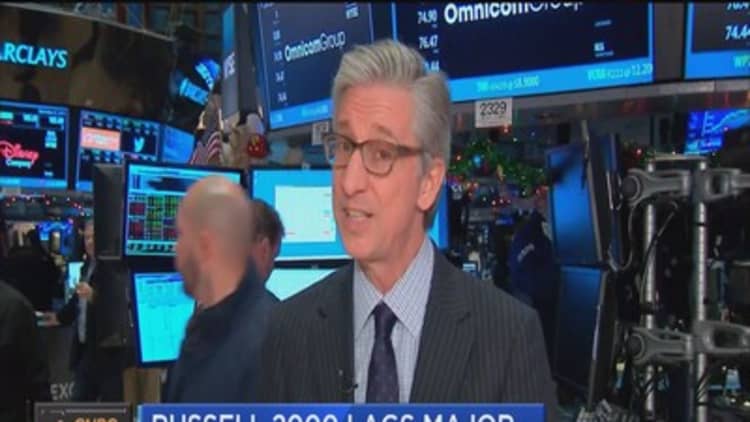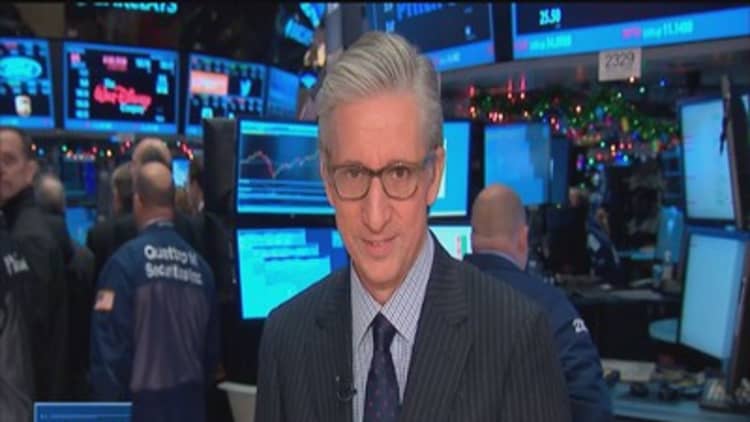



U.S.stocks closed lower in light volume trade Thursday, the last day of 2015, despite some stabilization in oil prices. (Tweet This)
The S&P 500 and Dow Jones industrial average both ended lower for the year, their worst since 2008. The Nasdaq composite closed up more than 5.5 percent for the year helped by outperformance in biotech stocks and major tech names, except Apple. The iPhone maker's stock turned in its first negative year since 2008.
The Russell 2000 and Dow transports also had their worst year since 2008.
Major index 10-year performance
Selling accelerated into the close Thursday, with the Dow closing about 180 points lower. The Nasdaq composite fell more than 1 percent as Apple declined nearly 2 percent.
The S&P 500 ended nearly 1 percent lower on the day, with energy the only sector clinging to slight gains as oil settled higher, but remaining near multi-year lows. Energy was the worst-performing S&P 500 sector, falling more than 20 percent.
"I think the big moves have already been made and investors are now positioning for next year," said Adam Sarhan, CEO of Sarhan Capital, noting focus for traders Thursday was likely around the week-to-date, quarter-to-date and year-to-date levels.
With Thursday's decline, the major U.S. averages ended the week more than half a percent lower. The indexes were up nearly 6.5 percent or more for the quarter, their best in two years.
The S&P 500 ended the year down 0.73 percent after three-straight years of double-digit gains. The index's last major negative year was in 2008, when the S&P lost 38.49 percent.
The Dow Jones industrial average was off 2.23 percent for the year, its first negative year since 2008 when the index lost more than 30 percent.
Despite a volatile year that saw the major U.S. averages plunge more than 10 percent, the indexes ended about 5 percent or less away from their record intraday highs.
"I think if flat's the new up, 2015 for equities was a pretty exemplary year," said Ryan Larson, head of equity trading, U.S., at RBC Global Asset Management (U.S.). "Finishing flat is a relative win given what we saw in the latter half of 2015."
With the Federal Reserve's first rate hike out of the way and little economic news in the last two holiday-shortened trading weeks, stock market action has been tightly correlated to moves in oil and other commodities.
"We did somewhat track the movements in WTI earlier. ... Other than that the tone has been set by very limited overseas action. (It's an) extremely light volume day," Larson said.
"For the limited people that are in, it could be closing up positions for year-end," he said.
Trade volume this week was among the lowest of the year, ahead of Friday's New Year's Day holiday when markets are closed. However, volume Thursday topped 5 billion across exchanges, surpassing last New Year's Eve volume of 4.58 billion shares.
"Probably more urgency to sell than to buy. That's why we're down," said James Meyer, chief investment officer at Tower Bridge Advisors.
"It's a day of portfolio adjustments. I think you're going to find some people taking some money off the table and switching to more conservative (assets). So bonds are up and stocks are down," he said.
Read MoreLots of fireworks but no grand finale for stocks
U.S. crude oil futures settled up 44 cents, or 1.2 percent, at $37.04 a barrel. However, WTI lost more than 30 percent for 2015, for its first two-year losing streak since the late 1990s.
Brent settled at $37.28 a barrel for its third-straight year of decline.
Oil held higher in intraday trade but remained near seven-year lows. The U.S. oil drilling rig count showed a decline of 2, according to Baker Hughes.
Brent turned positive in intraday trade as a fierce storm in the North Sea forced oil firms to evacuate platforms and shut down production Thursday.
Also on Thursday, Iran President Hassan Rouhani ordered his defense minister to expand Iran's missile program, in response to a U.S. threat to impose sanctions over a ballistic missile test Iran carried out in October.
"I think this is going to be a short-lived bounce in energy prices," said Robert Pavlik, chief market strategist at Boston Private Wealth.
U.S. crude oil fell more than 3 percent Wednesday to settle below $37 a barrel, contributing to the Dow Jones industrial average's decline of about 117 points Wednesday.
Natural gas traded about 5 percent higher. Inventories showed a decline of 58 billion cubic feet in the week ended Dec. 25, according to StreetAccount.
In a light day of economic news, the Chicago Purchasing Managers' Index (PMI) came in at 42.9 for December, down from 48.7 in November.
"This really undermines those expectations for the new year to be that year of improvement," said Lindsey Piegza, chief economist at Stifel.
"This is not the type of data the Fed wants to see after the monumental change in December. We may see more downside in the economy," she said.
Weekly jobless claims came in at 287,000, up from 267,000 the week before.
Treasury yields held lower, with the around 1.06 percent and the 10-year yield near 2.27 percent in the close.
The U.S. dollar traded higher against major world currencies, with the euro falling below $1.09.
The Dow Jones industrial average closed down 178.84 points, or 1.02 percent, at 17,425.03, with Apple leading decliners and General Electric the only advancer.
Nike was the best performer in the Dow for the year, while Wal-Mart was the worst.
The closed down 19.42 points, or 0.94 percent, to 2,043.94, with information technology leading nine sectors lower and energy the only advancer.
Netflix was the top S&P 500 stock for the year, while Chesapeake Energy was the worst. Consumer discretionary was the best sector, while energy was the worst.
The Nasdaq composite declined 58.43 points, or 1.15 percent, to 5,007.41.
The iShares Nasdaq Biotechnology ETF (IBB) closed lower on the day but gained 11.5 percent for the year, its seventh-straight year of gains.
The CBOE Volatility Index (VIX), widely considered the best gauge of fear in the market, held near 18.
About three stocks declined for every two advancers on the New York Stock Exchange, with an exchange volume of 753 million and a composite volume of nearly 2.7 billion.
High-frequency trading accounted for 49 percent of December's daily trading volume of about 7.24 billion shares, according to TABB Group. During the peak levels of high-frequency trading in 2009, about 61 percent of 9.8 billion of average daily shares traded were executed by high-frequency traders.
Gold futures for February delivery settled up 40 cents at $1,060.20 an ounce. The precious metal lost more than 10 percent for the year, posting three-straight years of decline for the first time since 1998.
Read MoreEarly movers: LMT, GE, GM, AAPL, MSFT, T, CMRX & more
On tap this week:
Friday
New Year's Day holiday
Markets closed
*Planner subject to change.
More From CNBC.com:


